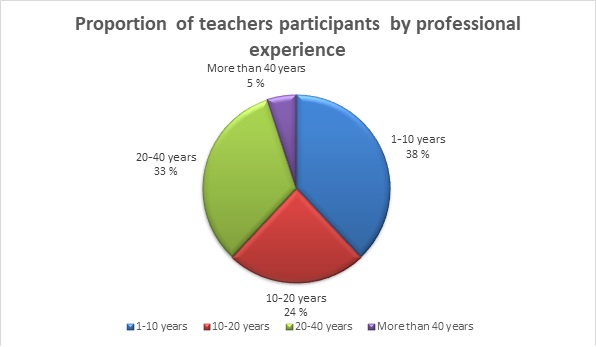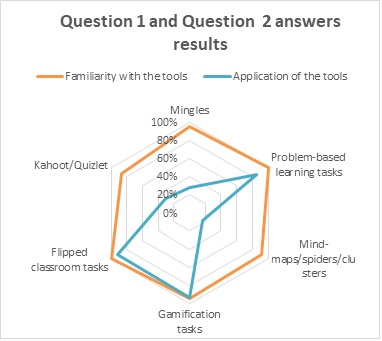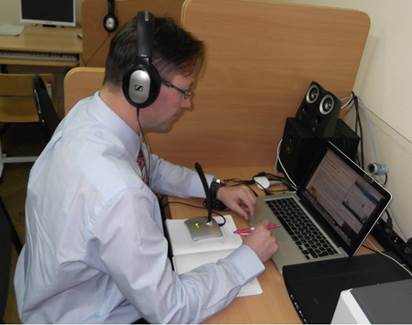Education in any context is based on a curriculum which is a structured plan of instruction that outlines the goals and content for teaching and learning of any academic course in compliance with standards requirements. It sets general guidelines for teachers which need to be practically implemented in everyday classroom activities both online and offline through the use of varied didactic tools. Didactic tools can be generally defined as a reasonable combination of diverse methods, aids, materials, tasks, and techniques, both digital and traditional, which are expected to promote student quality learning.
In foreign language education, related national standards and curricula often rely on the CEFR which is a worldwide standard framework for language skills and abilities [17] where six levels of foreign language competency are described. The subject-specific aim of foreign language education is defined as the foreign language communicative competence at a certain level of its development. This competence is based on the system integration of language sub-skills, skills, soft skills, knowledge, and personal qualities which enable the student to effectively use the foreign language for varied meaningful purposes [2]. To achieve any competence level, teachers need to design such student practices that will lead to the desired outcomes. Obviously, a complex character of the expected outcomes as well as a diversity of learners with different features and needs require a great variety of didactic tools to facilitate learning. Thus, designing lesson and homework plans is based on didactic logistics which we define as the overall process of planning, organizing, and managing practical teaching and learning. An essential part of didactic logistics refers to identifying effective and accessible ways and tools to engage students in appropriate activities to become familiar with the content, to store and process information, and to develop the target competence components while using the content for real life goals. It is evident that there must be coherence and consistency among the goals, the tools, and the agents who apply them to optimize education processes from beginning to end. An education logistics management system therefore implies making efficient decisions in selecting appropriate tools and placing them wisely in the teaching plan intended for student learning.
The aim of the present article is to find out if foreign language teachers are aware of some didactic tools that have been highlighted in foreign language methodology in recent years and if they apply these tools in their practices to improve the student learning outcomes. Through this study, we will be able to conclude to some extent if teachers are skilled at the logistics management system applied in foreign language education. Our choice of the didactic tools for foreign language education was random based on our research and practical experiences. We brainstormed for those that are often described in related articles and discussed at research conferences and then we investigated if they are used in foreign language teachers` practices.
Literature Review
There has been a lot of research of varied scope concerning the use of diverse didactic tools and their effects on learners in different education contexts, both offline and online. The world's largest and the most impressive one on what works best in schools to improve student learning is that compiled by J. C. Hattie since 2009 who has synthesized nearly 1,850 meta-analyses of varied factors that affect student achievement comprising more than 108,000 studies [7; 24]. These factors are related to seven areas that contribute to learning: the student, the home, the school, the curricula, the teacher, teaching and learning approaches, and the classroom [7; 23; 24]. The application of quantitative-empirical research method allowed Hattie to create a data-rich result and scale up smaller studies from the point of view of their influences on school-aged students achievements.
Another broad study deals with top digital tools for learning in the 21st century based on the open annual survey conducted by Jane Hart [21]. It reveals the overall rankings of different platforms, apps, technologies, resources, or networks that voters use for learning. In contrast to Hattie`s research, there is no analysis of the possible effects that these tools may produce on the learning outcomes. Still, it provides a broad picture of the possibilities that teachers and students have at their disposal to improve learning.
What we can conclude from the studies mentioned above is the idea that course book writers and teachers have access to an enormous range of tools and techniques to choose from in designing the logistics of their teaching and learning practices. The issue is whether university foreign language teachers are aware of this variety and whether they implement at least the most widely described tools in the classroom.
For our study we selected a few didactic tools of diverse character: Kahoot / Quizlet, Mingles, Mind maps, Problem-based learning, Gamification, and Flipped classroom.
To identify whether these tools attract the interest of researchers in teaching languages, we have compiled some statistics using the search engines, websites and databases which provide access to academic papers in the sphere of education. The criteria which influenced the choice of these search engines / websites / databases were:
- free access since many teachers do not have access to databases of Scopus and Web of Science, and
- the provision of some numerical data on the number of the articles on a particular topic as it can illustrate research interest in this area and indicate the occurrence of the tools in scholarly literature.
The statistics presented in Table 1 prove that these tools are a subject to numerous research articles and attract scientific attention. As the access to these materials is free, it could be assumed that these tools can be widely used by teachers in their practices.
Table 1
Didactic tools frequency on academic search engines
| Didactic Tools | Google Scholar | Academia.edu | ERIC Project
Institute of Education Sciences |
Cyberleninka
(accessed on 24.07.2022) |
| Kahoot / Quizlet | 37 600 / 14 800 | 410 / 103 | 97 / 37 | 345 / 264 |
| Mingles teaching language | 71 600 (929 reviews papers) | 4942 | 3 | 2 |
| Mind map
Teaching language |
1 300 000 (18 100 reviews papers) | 15177 | 1068 | 479 |
| Problem-based learning
Teaching language |
343 000 (7 950 reviews papers) | 120 348 | 111548 | 1186 |
| gamification teaching language | 37 400 (2 460 reviews papers) | 13 700 | 23 | 641 |
| Flipped classroom | 83 300 (4 450 reviews papers) | 21888 | 17192 | 586 |
Researchers highlight the following characteristics of the selected tools.
Kahoot / Quizlet are special game-based platforms for content knowledge, vocabulary and grammar practices as well as formative assessment which enhance student motivation, provide immediate feedback, and encourage learners to use the language flexibly [8; 9; 11]. Researchers conclude that Kahoot! can capture, sustain, and increase student motivation, allowing them to feel more comfortable [9]. Similar advantages are mentioned by researchers of Quizlet which is a multifaceted software that helps language learners to develop vocabulary fluency [11]. Quizlet presents learners with «metacognitive strategies in the sense that they can decide on which/how/how often words to practice» (11, p. 52) learning vocabulary at their own pace, and improves the tracking of individual student progress (teachers can create a class and have students join) [11].
A mingle is an activity which involves learners` interaction with one another to complete a task with different partners in turn [10–13]. Mingles are an effective form of both offline and online classroom management technique when students can improve the flexibility of language sub-skills (vocabulary and grammar) and of productive speech skills (mediation, discussion, and conversation) being actively involved in interaction for different purposes with different partners. The biggest advantage of this tool is their multifunctional character because, in addition to subject specific skills and competences, they contribute to the enhancement of soft skills (higher order thinking strategies, communication, and collaboration,) due to their potential to amplify the learning environment [2].
A Mind Map is a graphic tool which contains a central key word or image and secondary ideas that radiate from the central idea as branches. The key idea crystallizes the subject of attention while the branches represent the connections established with the central idea, forming aconnected nodal structure [16]. Mind mapsas well as other ways of visualization can be widely used in teaching and learning foreign languages for varied objectives: to practice vocabulary and grammar, to scaffold listening and reading comprehension, and to develop the learner’s oral fluency [14; 15; 16; 26]. They make it easier to process and store information and the related vocabulary because they present any topic visually as a whole with numerous inherent links and logic.
Problem-based Learning (PBL) suggests the use of problem-solving and inquiry-based tasks when students acquire and master knowledge and skills while working on a complex problem similar to those in the real world [10]. This method can be implemented through a series of tasks such as projects, case studies, complex role-plays, creative writing, or debates, etc. [1; 27; 28; 32; 33]. The goals of the tasks is to have students investigate a problem and come up with a well-grounded and well-thought through solution, generating questions, identifying key ideas, collecting data and analyzing facts and opinions, thus working their ways to a potential solution which they will present to the class for discussion. It is evident that to this end they have to pool all their resources (listening, reading, speaking, and writing skills, thinking strategies, versatile knowledge, communication, cooperation and creative abilities) [1; 27; 28; 32; 33]. In this case, learning takes place through self-directed discovery and critical reflection.
Gamification implies the use of game-based elements which make teaching and learning a more collaborative and enjoyable process [6; 12; 22; 25; 30]. According to Shahri et al. [27], it uses game-based components and game principles in anon-game context to engage users more, to increase retention capturing a positive change in human behavior [26]. There is a wide range of gamification elements such as storytelling, competition, feedback, points, level, leaderboards, time-based, avatars [6]. Gamification elements can be combined with different techniques and tasks, they can accompany the use of different aids and materials, promoting student emotional comfort [11].
The flipped classroom approach [5; 19; 31] makes learning self-directed when students are engaged in completing homework assignments that are based on new knowledge or language, preparing for the next class independently. In this way it is possible to enhance their subject-specific as well as soft skills and develop responsibility for the outcomes, promoting learner engagement and autonomy.
Rational
The list of the didactic tools described above is not exhaustive. It is impossible to examine a broad variety of all those that foreign language teachers use. Nevertheless, while selecting the tools for the study, we focused on those that comply with the major approaches of modern foreign language education, such as the action-oriented approach «based on real world communicative needs and organized around real-life tasks» [17, p. 26] when «teaching and learning process is driven by action» [17, p. 27] aimed at self-expression, active thinking, interaction, and collaboration; the learner-centered approach seeing learners as language users and social agents [17, p. 27] who self-regulate and direct their actions to attain certain outcomes; the inquiry-based developmental approach to learning which allows each student to grow as a person and as an agent.
A combination of the tools in the teaching process covers all the principal objectives of modern foreign language education (subject-specific and soft skills), promotes enjoyable and diversified learning conditions, thus increasing motivation in learners. There fore, it is possible to assume that the use of the tools under study promotes student social, intellectual, emotional and behavioral engagement which is considered a significant prerequisite of effective teaching and learning.
The review of the research papers allows to conclude that foreign language teachers need to be aware of the tools selected for the study and should incorporate them into their practices on a regular basis.
Methodology
The study was conducted from September 2021 to May 2022 and aimed to reveal (A) if the teachers are familiar with didactic tools which are widely discussed in research papers and at various events (conferences, round tables etc) and (B) if these tools are used by the teachers in their regular practices.
87 teachers of levels of education took part in the study. As the range of the tools selected for the study is universal, polyfunctional, and can be used in varied contexts for different purposes, teachers of all levels of language education (primary, secondary, tertiary) took part in the study. Their teaching experience varied from 2 to 42 years. A more detailed information on the proportion of teacher participants by their professional experience is presented in Table 2 and Figure 1.
Table 2
Participants` work experience
| Work experience | Teacher’s percentage, % |
| 1–10 years | 38 |
| 10–20 years | 24 |
| 20–40 years | 33 |
| More than 40 years | 5 |

Fig. 1. Proportion of teachers participants by professional experience
All the participants filled in the questionnaire which included the following questions.
Q1. Are you familiar with the following types of activities:
- mingles;
- problem-based learning tasks;
- mind-maps / spiders / clusters;
- gamification tasks;
- flipped classroom tasks;
- kahoot / Quizlet.
Q2. Do you use the following types of activities in your teaching practices offline and online?
- mingles;
- problem-based learning tasks;
- mind-maps / spiders / clusters;
- gamification tasks;
- flipped classroom tasks;
- kahoot / Quizlet.
As the answers to Question 2 could vary, Questions 3 and 4 were divided into 2 options 3(A) / 3(B) and 4 (A) / 4(B). The teachers used the following algorithm (Figure 2) while answering these questions:
- if the respondent answered Q2 positively (yes), they had to answer Q3A and Q4A;
- if the respondent answered Q2 negatively (no), they had to answer Q3B and Q4B.
| Question 2
Yes / No |
||
| YES | NO | |
| Q3A. Why do use these didactic tools?
|
Q3B. Why do not you use them?
|
|
Q4A. Give examples of the activities that you use.
|
Q4B. Give examples of the activities that you could use.
|
Fig. 2. Question sequence algorithm
Results
Answers to questions1 and 2 were analyzed and presented in tables 3–4.
Table 3
Familiarity with the didactic tools under review
| Question 1 | Number of teachers | Total percentage of the teachers, % |
| Mingles | 83 | 95 |
| Problem-based learning tasks | 87 | 100 |
| Mind-maps / spiders / clusters | 79 | 91 |
| Gamification tasks | 83 | 95 |
| Flipped classroom tasks | 87 | 100 |
| Kahoot / Quizlet | 76 | 87 |
As it can be seen from table 3, teachers are very well aware of the didactic tools selected for the study as from 87 % to 100 % of the participants answered question 1positively. The overwhelming majority of the teachers are well-versed in these didactic tools.
Table 4
Practical application of the didactic tools by teachers
| Question 2 | Number of teachers | Total percentage of the teachers, % |
| Mingles | 24 | 28 |
| Problem-based learning tasks | 73 | 85 |
| Mind-maps/spiders/clusters | 15 | 17 |
| Gamification tasks | 81 | 93 |
| Flipped classroom tasks | 80 | 92 |
| Kahoot / Quizlet | 27 | 31 |
Turning to the answers to question 2, they appeared to be quite different from the answers to question 1. This mismatch between the teachers` familiarity with the didactic tools under review and their practical application in teaching is presented in Figure 3.

Fig. 3. Question 1 and Question 2 answers results
Apart from gamification tasks, flipped-classroom tasks and problem-based learning tasks,all the other didactic tools are underused by the teachers.
The reasons why the teachers implement the didactic tools in their professional activity are presented in table 5.
Table 5
Reasons for using the didactic tools under review
| Question 3A | Number of teachers | Total percentage of the teachers, % |
| Learners’ active involvement | 32 | 37 |
| Better learning outcomes | 18 | 21 |
| More fun for students | 16 | 18 |
| More creative | 27 | 31 |
The reasons why the teachers refrain from using the didactic tools are presented in table 6.
Table 6
Reasons for not using the didactic tools under review
| Question 3B | Number of teachers | Total percentage of the teachers, % |
| Not clear how to use them | 28 | 32 |
| Lack of practical experience | 39 | 45 |
| No time during the lesson | 51 | 59 |
| Stick only to the coursebook which does not contain such tools | 42 | 48 |
| It takes time to incorporate them into lesson plans | 23 | 20 |
The teachers were asked to give some examples of the activities they use. Their ideas are presented in table 7 and 8.
Table 7
Teachers` task examples
| Question 4A | |
| Mingles | Make up a questionnaire (2–5 questions about…) and interview your classmates
Interview / poll your groupmates. Present your experience at least to three groupmates and listen to their experiences. Choose the one that impressed you and explain why. Present the news you have learned from your partner to your groupmate and listen to the news they have learned |
| Problem-based learning tasks | Make up a questionnaire (2–5 questions about…) and poll your classmates.
Consider several ways to deal with the problem of… Look at the problem from different perspectives (parents, teachers, teenagers, etc.) Study the situation and offer a solution which could benefit different people involved |
| Mind-maps / spiders / clusters | Make up a mind map /spider to present the key ideas of the text/ vocabulary on the topic/ problem issues |
| Gamification tasks | Role-play Interview
Quiz Grammar / vocabulary / phonetics contest Team competition (vocabulary, ideas, advantages –disadvantages, etc.) |
| Flipped classroom tasks | Read the text at home and prepare for the problem discussion in the classroom |
| Kahoot / Quizlet | Make up a list of the topic vocabulary for your group / for yourself to complete a task on Kahoot |
Table 8
Tasks offered by the teachers who do not use the didactic tools under review
| Question 4B | |
| Mingles | Discuss in pairs |
| Problem-based learning tasks | Discuss the problem and offer a solution
Project Consider the pros and cons of… |
| Mind-maps / spiders / clusters | Make up a mind-map of the topical vocabulary
|
| Gamification tasks | Role-play a dialogue
Quiz Team competition Contests |
| Flipped classroom tasks | Read the text at home / study the topic at home |
| Kahoot / Quizlet | Make your quiz / vocabulary list using Kahoot or Quizlet |
Discussion
The results of the study turned out to be quite unexpected in terms of the authors’ assumption that if the didactic tools chosen for the study are widely presented in scholarly literature, these tools should be widely used in the language learning classroom.
The respondents’ answers to the first question which aimed to reveal the teachers’ familiarity with these tools have shown that a vast majority of the teachers know about these tools (mingles, problem-based learning, mind-maps, gamification, flipped classroom, Kahoot / Quizlet). Problem-based learning and flipped classroom are familiar to 100 % of the respondents, 95 % of the teachers have heard/read about mingles and gamification, 91 % of the teachers have some idea about the use of mind-maps/spiders/clusters while Kahoot and Quizlet were mentioned by 87 % of the respondents which makes it the least common answer. It can be concluded that teachers of all levels of education have theoretical knowledge about these tools.
However, when it comes to the practical application of these tools, the situation changes dramatically. The didactic tools widely used in language teaching practices have proved to be gamification, flipped classroom with focus on self-directed learning and problem-based learning. 93 %, 92 % and 85 % of the respondents respectively apply gamification, flipped classroom and problem-based learning in their practices. The number of teachers who use other tools (mingles, mind-maps, and Kahoot / Quizlet) varied from 17 % to 31 % with mind-maps being the least common option. Mind-maps/clusters/spiders potential to practice vocabulary and grammar, to scaffold listening and reading comprehension, and to develop the learner’s oral fluency [14; 15; 16; 26] is underused by the teachers. The second and third least practically used options turned out to be mingles and Kahoot / Quizlet which are put to use by approximately the same number of the teachers which accounted for 31 % and 28 % respectively. However, those who use them, are well aware of their benefits, among which the teachers mentioned learners’ active involvement (37 %) and better learning outcomes (21 %) along with more fun (18 %) and creativity (31 %).
Among the reasons for not using the didactic tools under review, the teachers named the lack of knowledge and practical experiences in the area which accounted for 32 % and 45 % respectively. The lack of time during the lesson appeared to be the most common reason with 59 % of the respondents providing this answer. Meanwhile 48 % of the teachers stick to the coursebooks that do not offer such tasks which correlates with the results of the teachers’ agency study [4]. This fact indicates one more area for concern as coursebooks used at different levels of language education do not contain the tasks based on the use of these didactic tools.
The examples of the tasks used by the teachers in their practices turned out to be more diverse than the tasks offered by the teachers who do not use them.
The study has revealed a gap between teachers’ knowledge base of didactic tools and their practical skills in applying this knowledge. The vast majority of the respondents have a theoretical background while only a third part of the teachers use these tools in their teaching practices.
Familiarity with didactic concepts and scholarly literature does not ensure the implementation of the didactic ideas and tools in everyday teaching. It can be assumed that teachers need clearer guidelineson how to use these tools backed up with a variety of practical examples and focus on multifunctional tasks which can simultaneously develop subject-specific and soft skills and lead to integral learning outcomes [13]. Pre-service and in-service teacher trainers as well as teachers themselves should have access to summative reviews or digests based on practical research data which present the logistics management system guidelines applied in blended foreign language education. Clear task requirements and algorithms on how to build such techniques, activities, materials, aids, and tasks can encourage both teachers’ agency and a more active and creative application of effective didactic tools which have been proved effective by researchers. This may be one of the ways of how to bridge the gap between academic research and practical application of its results.
However, we admit that the study has some limitations as the number of the questioned teachers was limited and they were not divided into groups according to the level of their student language education they teach. There needs to bea further study with more focus on different tools used at different levels of blended language education. The second limitation touches upon the list of the didactic tools used as only a limited range of tools was selected for the study.
Conclusion
In spite of the teachers` awareness of a variety of effective didactic tools and some theoretical background in this area, only some of the tools are widely put into practice by the teachers at all levels of language education. Much attention is paid to self-regulated learning (flipped classroom), problem-based learning and gamification, all of these tools being present in the foreign language coursebooks. Meanwhile, when it comes to less popularized by foreign language coursebooks tools such as mingles, mind-maps and the use of apps, their practical application tends to be inconsistent with their potential.
It reveals a significant gap between theory and practices of teaching foreign languages and enhances the need to develop clearer guidelines and step-by-step algorithms to encourage teachers to become more agentic in their teaching activities and introduce a wider variety of effective didactic tools into their classrooms.
References
- Alan B., Stoller F. L. Maximizing the benefits of project work in foreign language classrooms. In: English Teaching Forum. 2005. № 43 (4). P. 10–21.
- Borzova E., Shemanaeva M. А University Foreign Language Curriculum for Pre-Service Non-Language Subject Teacher Education. In: Education Sciences. 2019. Vol. 9 (3). P. 163.
- Borzova E. Mingles in the Foreign Language. In: Classroom English Teaching Forum. 2014. № 52 (2). P. 20–27.
- Borzova E., Shemanaeva M. Foreign Language Teachers as Agents of Using a Coursebook. In: TSNI 2021 TEXTBOOK Focus on Students National Identity. Moscow, 2021. P. 198–215.
- Demyanova Z. Use of the Flipped Class Model in Teaching English to Master’s Students at a Technical University. Integration of Engineering Education and the Humanities: Global Intercultural Perspectives Proceedings of the Conference Integrating Engineering Education and Humanities for Global Intercultural Perspectives. St. Petersburg. Springer Cham, 2022.
- Dicheva D., Dichev C., Agre G., Angelova G. Gamification in education: A systematic mapping study. In: Journal of Educational Technology and Society. 2015. № 18 (3). P. 75–88.
- Hattie J. A. C., Yates G. Visible Learning and the Science of how we Learn. Routledge, UK, 2014. 368 p.
- Hildebrandt K. Integrating Second Language Learning Online. In: Integration of Instructional Design and Technology to Support Rapid Change. Sidney, Australia. 2020.
- Licorish S. A., Owen H. E., Daniel B., George J. L. Students’ perception of Kahoot!’s influence on teaching and learning. In: Research and Practice in Technology Enhanced Learning. 2018. № 13 (9). P. 1–23.
- Ormrod J. E. Educational psychology: Developing learners. Upper Saddle River. In: NJ: Pearson Merrill Prentice Hall. 2006. 848 p.
- Toy F., Buyukkarci K. The Effects of Quizlet on Foreign Language Learners’ Vocabulary Learning Success and Perceptions.In: i-Manager’s Journal of Educational Technology. 2019. № 16 (3). P. 44–60.
- Al-Dosakee K., Ozdamli F. Gamification in Teaching and Learning Languages: A Systematic Literature Review [Electronic resource]. In: Revista Romaneasca pentru Educatie Multidimensionala. 2021. № 13 (2). P.559–577. Electron dan. DOI: https://doi.org/10.18662/rrem/13.2/436 (date of acсess: 22.12.2022).
- Borzova E., Shemanaeva M. Multifunctionality: A Top Down Projection of University Foreign Language Education [Electronic resource]. In: Lifelong Education: the 21st century. 2021. № 2 (34). Electron dan. DOI: http://dx.doi.org/10.15393/j5.art.2021.6926 (date of acсess: 09.01.2023).
- Buran A., Filyukov A. Mind Mapping Technique in Language Learning [Electronic resource]. In: Procedia – Social and Behavioral Sciences 206:215–218 XV International Conference «Linguistic and Cultural Studies: Traditions and Innovations», LKTI 2015. Electron dan. DOI: https://doi.org/10.1016/j.sbspro.2015.10.010 (date of acсess: 09.12.2022).
- Budd J. W. Mind Maps As Classroom Exercises [Electronic resource]. In: The Journal of Economic Education. 2004. № 35 (1). P. 35–46. Electron dan. DOI: http://dx.doi.org/10.3200/JECE.35.1.35-46 (date of acсess: 09.12.2022).
- Casco M. The Use of «Mind Maps» in the Teaching of Foreign Languages. [Electronic resource] XXXV FAAPI Conference Proceedings. Bahía Blanca, 2009. Electron dan. URL: https://wlteacher.files.wordpress.com/2013/02/mindmaps.pdf (date of acсess: 09.12.2022).
- Common European Framework of Reference for Languages: Learning, Teaching, Assessment. Companion Volume with New Descriptors. 2020. [Electronic resource]. Electron dan. URL: www.coe.int/lang-cefr (date of acсess: 09.12.2022)
- Darmayenti D., Nofiadri N., Darmayenti D., Nofiadri N. Mingle Model for Teaching English Speaking Skill for College Students. [Electronic resource]. In: Al-Ta lim Journal. 2015. № 22 (1). P. 1–9. Electron dan. DOI: http://dx.doi.org/10.15548/jt.v22i1.115 (date of acсess: 09.12.2022).
- Flipped Learning Global Initiative. 2017. [Electronic resource]. Electron dan. URL: https://flglobal.org [Google Scholar] (date of acсess: 09.10.2022).
- Febriani S. R., Wargadinata W., Syuhadak. Mingle Model for Increasing Productive Language Skills and Realation shipwith Student’s Personality based on Jung Theory [Electronic resource]. In: Ta’lim al-‘Arabiyyah: Jurnal Pendidikan Bahasa Arab & Kebahasaaraban. 2021. № 5 (1). P. 35–51. Electron dan. DOI: http://dx.doi.org/10.15575/jpba.v5i1.12184 (date of acсess: 09.12.2022).
- Hart J. The Top Tools for Learning [Electronic resource]. 2021. Electron dan. URL: https://www.toptools4learning.com/ (date of acсess: 09.12.2022).
- Hamari J., Shernoff D. J., Rowe E., Coller B., Asbell-Clarke J., Edwards T. Challenging games help students learn: An empirical study onengagement, flow, and immersion in game-based learning [Electronic resource]. In: Computers in Human Behavior. 2016. № 54. P.170–179. Electron dan. DOI: https://doi.org/10.1016/j.chb.2015.07.045(date of acсess: 09.12.2022).
- Hattie J. Hattie Ranking: 252 Influences and Effect Sizes Related to Student Achievement [Electronic resource]. 2018. Electron dan. URL: www.visiblelearningplus.com/content/250-influences-student-achievement (date of acсess: 09.12.2022).
- Hattie J. The applicability of Visible Learning to higher education [Electronic resource]. In: Scholarship of Teaching and Learning in Psychology, 2015. № 1 (1). P. 79–91. Electron dan. DOI: https://doi.org/10.1037/stl0000021 (date of acсess: 09.12.2022).
- Garett R., Young S. D. Health care gamification: A study of gamemechanics and elements [Electronic resource]. In: Technology, Knowledge and Learning. 2018. № 24 (3). P. 341–353. Electron dan. DOI: https://doi.org/10.1007/s10758-018-9353-4 (date of acсess: 09.12.2022).
- Kapelyushnik E. V., Sheveleva S. I. Mind-maps as a Tool for the Formation of Communicative Competence in Online Learning of Russian as a Foreign Language [Electronic resource]. In: Modern problems of science and education. 2021. № 5. P. 39–49. Electron dan. DOI: http: //10.17513/spno.31140 (date of acсess: 09.12.2022).
- Khotimah S. The Use of Problem Based Learning to Improve Students Speaking Ability [Electronic resource]. In: ELT Forum: Journal of English Language Teaching. 2014. № 3 (1). Electron dan. DOI: https://doi.org/10.15294/elt.v3i1.4011 (date of acсess: 09.12.2022).
- Li F. A study of English reading strategies used by senior middle school students [Electronic resource]. In: Asian Social Science. 2010. № 6 (10). P. 184. Electron dan. DOI: http//10.5539/ass.v6n10p184 (date of acсess: 09.12.2022).
- Rahman M. A., Ja’afar H. A Review of the Mingle Model as a New Technique in Teaching Speaking: Indonesian Context [Electronic resource]. In: LET: Linguistics, Literature and English Teaching Journal. 2017. № 7 (2). Electron dan. DOI: http://dx.doi.org/10.18592/let.v7i2.1949 (date of acсess: 09.12.2022).
- Shahri A., Hosseini M., Phalp K., Taylor J., Ali R. How to engineer gamification: the consensus, the best practice, and the grey areas [Electronic resource]. In: Journal of Organizational and End User Computing. 2019. № 31 (1). P. 39–60. Electron dan. DOI: https://doi.org/10.4018/joeuc.2019010103 (date of acсess: 12.11.2022).
- Sams A., Bergmann J., Daniels K., Bennett B., Marshall H. W., Arfstrom K. M. The Four Pillars of F-L-I-P Flipped Learning Network (FLN) [Electronic resource]. 2014. Electron dan. URL: https://flippedlearning.org/wp-content/uploads/2016/07/FLIP_handout_FNL_Web.pdf (date of acсess: 09.10.2022).
- Tang S., Long M., Tong F., Wang Z., Zhang H., Sutton-Jones K. L. A Comparative Study of Problem-Based Learning and Traditional Approaches in College English Classrooms: Analyzing Pedagogical Behaviors Via Classroom Observation [Electronic resource]. In: Behav Sci. 2020. № 10 (6). P. 105. Electron dan. DOI: http //http://dx.doi.org/10.3390/bs10060105 (date of acсess: 09.12.2022).
- Wilson K. Critical reading, critical thinking: Delicate scaffolding in English for academic purposes (EAP). In: Thinking Skills and Creativity. 2016. № 22. P. 256–265.













